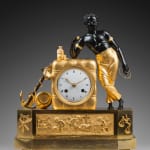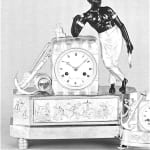
“The Sailor” clock in gilt, chased and patinated bronze, Paris, Empire period.
Mons, François Duesberg Museum
Jean-Simon Deverberie (attributed to) 1864-1824
Literature
Dominique and Chantal Fléchon, “La pendule au nègre”, in Bulletin de l’Association nationale des collectionneurs et amateurs d’horlogerie ancienne, Spring 1992, n° 63, p. 43.
A rare gilt and patinated Bronze Mantel Clock “The Sailor” attributed to Jean-Simon Deverberie
The round enamel dial features Roman numeral hours and Arabic fifteen-minute graduations, indicated by means of two pierced gilt bronze hands. The gilt bronze case is modelled as a bale of cotton, against which a young black man holding a cord is leaning. Shirtless and barefoot, he turns his head towards the left, holding a pipe in his right hand. His expressive face is rendered all the more so by his enamel or glass eyes, which contribute to the realistic effect of the piece. On the other side of the cotton bale there is an anchor and a barrel, symbols of commerce. The octagonal gilt bronze base is adorned with bas-relief motifs; the central scene features putti who are unloading and delivering merchandise and doing accounts. On either side there are applied allegorical trophies. The base is raised upon four “barrel” feet.
Paris, circa 1805-1810
Height 37 cm; width 30.5 cm; depth 11 cm
The black man as “noble savage” was rarely used as a decorative theme in French or European horological creations before the late 18th century. It was not until the end of the Ancien Régime – during the final decade of the 18th century and the early years of the 19th century - that the first clocks known as “au nègre “ or “au sauvage” began to appear. They reflect a philosophical movement expressed in literary and historical works such as Paul et Virginie by Bernardin de Saint-Pierre (which was published in 1787 and depicted the innocence of man); Atala by Chateaubriand (which restored the Christian ideal); and Daniel Defoe’s masterpiece Robinson Crusoe (published in 1719).
The present clock depicts a young black sailor resting after his work. While the design was registered by a Mr. Michel on August 20, 1808, the preliminary drawing by Deverberie, entitled “the sailor”, is included in the “Cahier de Dessin de Pendules” today in the Cabinet des Estampes of the Bibliothèque Nationale in Paris.
Very few similar pieces are known today. Among them, one example is preserved in the Andrès de Ribera Foundation in Jerez de la Frontera (illustrated in Catalogo ilustrado del Museo de Relojes, 1982, p. 37); a second clock is in the François Duesberg Museum in Mons (illustrated in Musée François Duesberg, Arts décoratifs 1775-1825, Bruxelles, 2004, p. 66).


